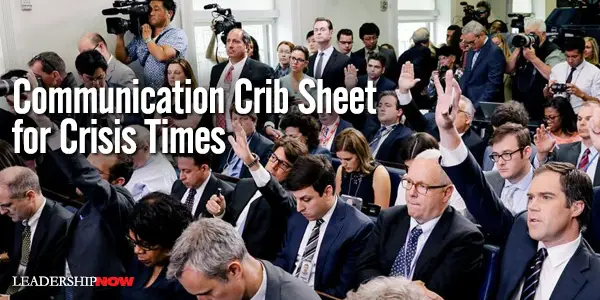Communication Crib Sheet for Crisis Times

IN AN excellent series of special reports on Managing in a Downturn produced by the Financial Times, Paul A. Argenti, professor of corporate communication at Tuck School of Business, Dartmouth College, observes that “many companies flail by failing to act or by taking the wrong kind of action when communicating with distressed stakeholders.” People are eager to listen and by acting quickly and thoughtfully, “a company can build reputational capital and weather the storm to come out on the other side perceived as a long-term leader.”
During a crisis, companies can uncover opportunity by adhering to a few simple guidelines when communicating with investors, employees, the press and the general public.
- Do not hide: not hearing from you will breed additional suspicion and mistrust among stakeholders
- Gather relevant information and stick to your story: be as informed as possible to reassure stakeholders that you are in control and in the know. Switching gears or waffling signals insecurity
- Communicate early and often: both internally and externally. Keeping employees well informed is a vital step to keeping your organization on message with all stakeholders
- Centralize communications: sending conflicting messages from different areas of a company signals disorganization and undermines stakeholder confidence
- Get inside the media’s head: anticipate how the press might spin first-hand or second-hand information
- Choose communication channels thoughtfully: how and where you say something is as crucial as what you are saying. During a period of distress, scrutiny of corporate communications is higher than ever as stakeholders clamor for information
- Communicate directly with affected constituencies: during times of instability and uncertainty, people want to be reassured by hearing information straight from the horse’s mouth
- Keep the business running: even in the face of upheaval, remind stakeholders that you have not taken your eye off your primary purpose as a for-profit corporation that drives returns for investors
- Keep values and character center-stage: in a period of crisis, maintaining trust is paramount. Adhering to corporate values, and using them as a navigational compass to guide corporate strategy and communications, will demonstrate stability and reliability, assuring stakeholders your head and heart are in the right place.
* * *

Like us on
Instagram and
Facebook for additional leadership and personal development ideas.



Posted by Michael McKinney at 10:45 AM
Permalink
| Comments (0)
| This post is about Communication









